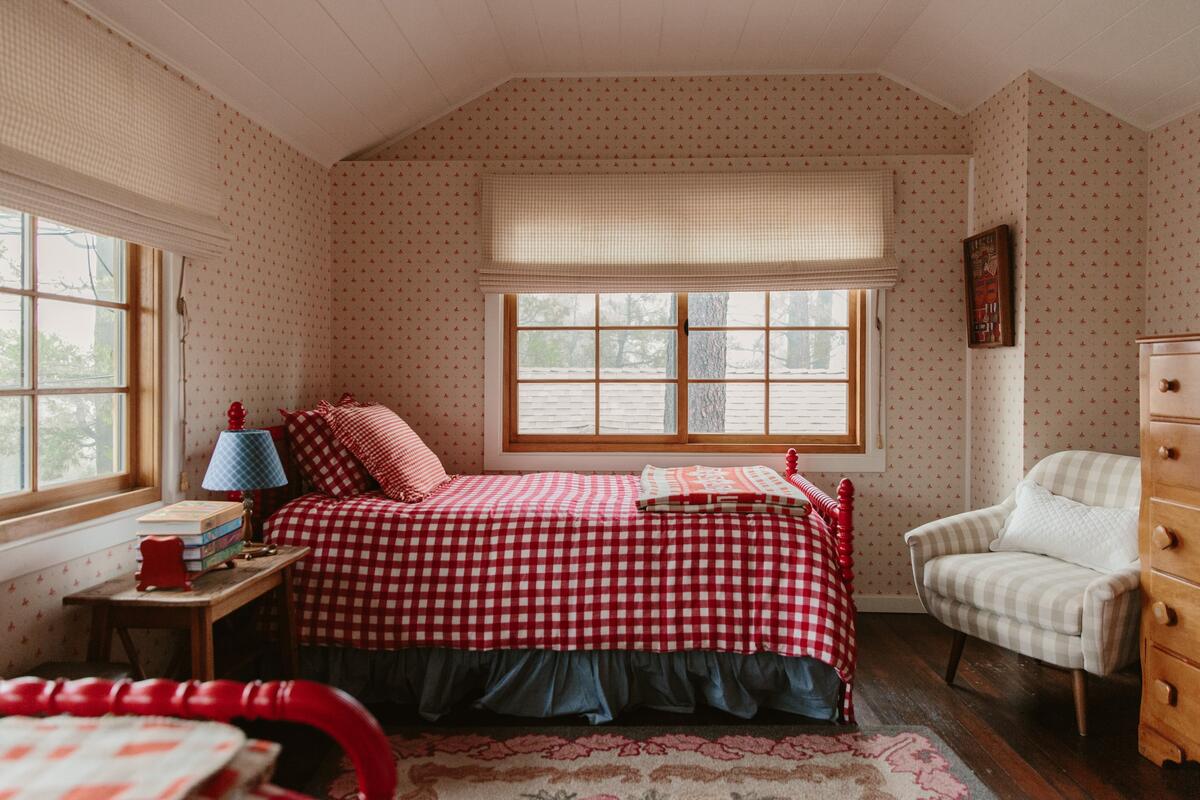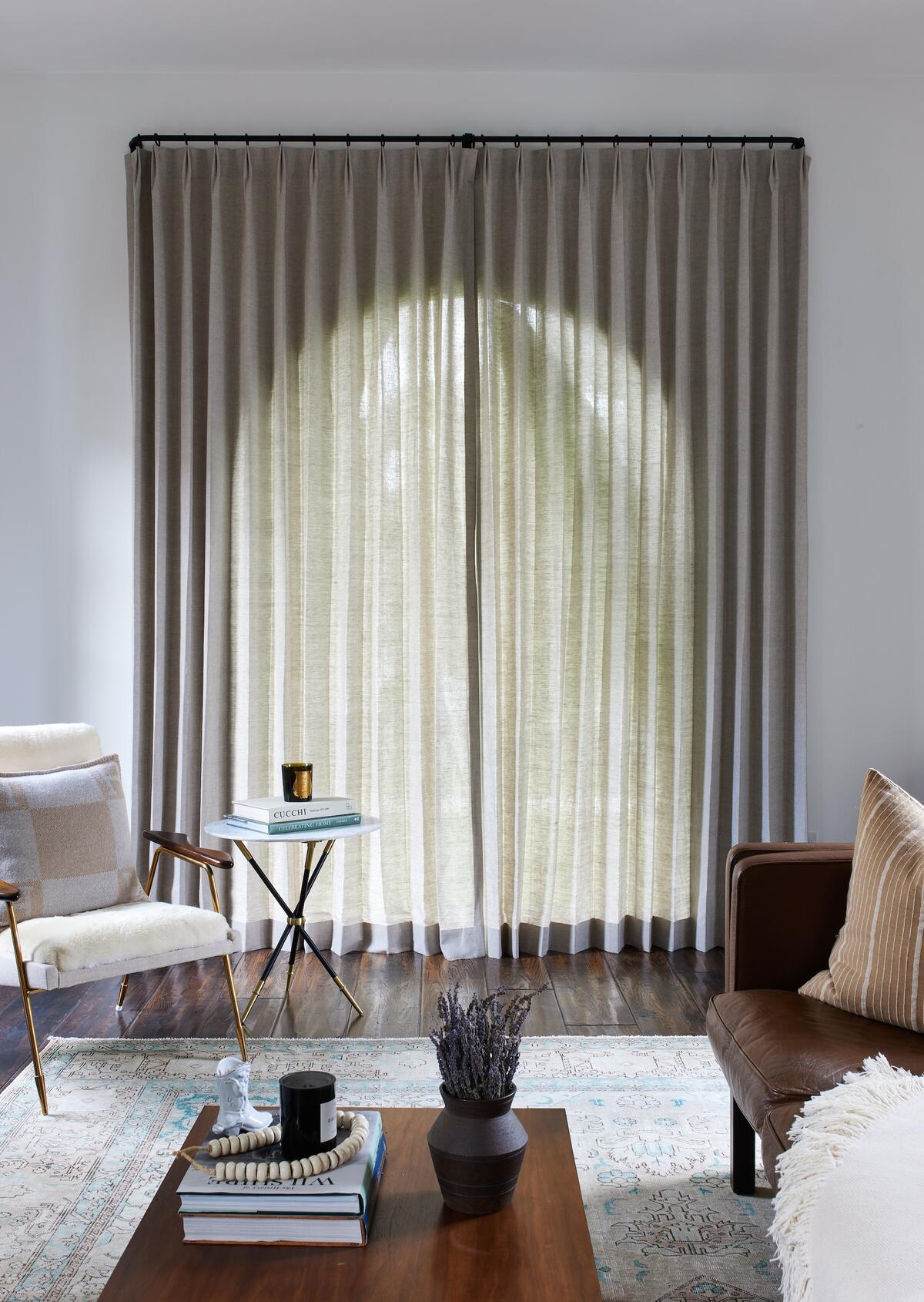The rise of terms like quiet luxury and stealth wealth has created a cottage industry dedicated to identifying the new inconspicuous signifiers of affluence—a category that includes everything from high-end light switches to Dyson vacuum cleaners. But the latest so-called status symbol instead points to the lack of a certain household item: window treatments.
A recent article in The Atlantic put forth the theory that uncovered windows have become “a fixture of high-end homes across America,” evidenced in part by various TikTok videos in which users document themselves window-peeping. The piece cited a 10-year-old study from the U.S. Department of Energy that further illustrated the point: Americans who earned more than $150,000 were almost twice as likely to leave windows uncovered than those making $20,000 to $29,000.
Have high-end-home owners really evolved past the need for windowcoverings? And is forgoing them the next frontier in displaying wealth? Designers and brands from across the industry tell a slightly different story. On the one hand, the category doesn’t appear to be going anywhere: Trend forecasting company WGSN named curtains as one of its top trends for 2024, and window treatment brands like Los Angeles–based Everhem say business hasn’t seen any slowdown in recent years.
“The idea of [no window treatments] being a status symbol—it’s a little far-fetched,” says Everhem founder Haley Weidenbaum. “Maybe people aren’t covering their windows because they don’t know where to start, or it’s too difficult.”
A former interior designer herself, Weidenbaum launched her company for that exact reason: The process of buying window treatments is often a difficult one. Even if you limit product and fabric options, the need for drapery that’s suited to windows and walls of varying sizes makes the entire category more complex for many everyday consumers and even designers.

“I think the scariest part of it is that it has to be customizable,” she says. “People are scared of things that are nonreturnable, so measuring is really a daunting part for customers who don’t want the responsibility or are not confident in measuring. … There are a lot of unknowns because it’s a very complicated product.”
While Dallas designer Jan Showers hasn’t observed any decreased interest in windowcoverings in her projects across the country, she echoes the idea that the winding process of ordering custom drapery might be keeping some homeowners from adding the finishing touches to their windows.
“Depending on the size of the house, the process can take anywhere from a month and a half to three to four months,” she says. “You’ve got to order the fabric, get everything measured—and then if it’s a good drapery-manufacturing company, you have to get in line, because the people who are really good are busy.”
Another roadblock to ordering window treatments: sticker shock. All of that fabric and intensive workroom attention adds up, Showers says. On average, designers say clients can expect to spend between $50,000 and $150,000 on custom high-end drapery for their entire home. (At the higher end of the spectrum, a now-viral clip from a Homeworthy video features designer Darren Henault recalling how he spent $10,000 on the trim alone for drapery in his home.) For homeowners who aren’t in the know and choose to save windowcoverings for last—or at least, after big-ticket furniture items have already been purchased—the expense can come as a surprise, and this may be one decor element they decide to push off indefinitely.
If they opt instead for inexpensive options from retail brands, it often exposes a quality disparity that can drag down the rest of an otherwise luxury space. Seattle designer Brian Paquette typically faces extended timelines for custom window treatments in a city where the design community competes for orders from just two local trade-only drapery workrooms. While there are some positive alternatives—he cites The Shade Store as a favorite—many other offerings on the market aren’t an ideal second option.
“Between custom window treatments that are made for your space and what you can buy off the rack that comes in something like an 84-inch or 96-inch length, the delta in quality is so vast,” he says. “I would rather see a beautiful room photographed without window treatments than with off-the-shelf window treatments.”
Atlanta designer Susan Ferrier acknowledges that there are some points the curtainless argument gets right—namely that the primary functions drapery used to serve in homes no longer apply for some homeowners. “[It used to be that] people of wealth—who could afford the best properties in the best settings with the best lighting and biggest windows—had to cover up all that glass for security reasons and for insulation,” she says. “Drapery and blinds were used on windows so that you felt safe and saved on your heating and air conditioning.”
Now, thanks to complex security systems and cameras, as well as central heat and air and improved insulation, homeowners can let the light in without compromising their privacy and comfort. But that doesn’t mean drapery falls entirely by the wayside. “I honestly think drapery has adapted its purpose, and that’s why we’re seeing more and more open windows—but just because you don’t see it, doesn’t mean it’s not there,” says Ferrier. “Form follows function, but because you don’t have drapery that meets a functional need anymore, drapery has migrated off the windows and onto walls.”
To that end, additional uses of drapery abound: It can be used to alter a room’s acoustics, fill empty walls in spaces with double-height ceilings, or soften the otherwise harsh or angular architectural qualities of a home. At the 2017 Kips Bay Decorator Show House in New York, Ferrier’s room included a wall with doors and moldings of various sizes, which appeared visually disjointed. Her solution? Dropping a drapery track along the entire wall.
“You get these spaces that are renovated, and then they’ve been renovated, and then they’ve been renovated, and there’s never been one point of view that’s carried on—that’s when you want to drape it,” she says. “When visual planes meet in a clumsy way, drapery can be used as a great way to heal that.”

As for privacy, many wealthy homeowners now let natural surroundings do the work rather than keeping the curtains or shades drawn to obscure what’s inside. Some use landscaping to provide a barrier while still allowing light in, while others opt for homes set further back from the street. For a project on Bainbridge Island, Paquette recently had a pair of clients opt out of windowcoverings for their secluded property.
“We were talking about window treatments in the bedrooms, and they’re like, ‘Yeah, we don’t want any,’” says the designer. “There’s no privacy issue because the house is located in the woods, and they like waking up with the sun.”
Letting in enough natural light is consistently a key concern among homeowners in any locale—which is why clients in rainy climates like Paquette’s home turf opt to go for lighter window treatments, and why so many owners of Brooklyn brownstones, limited to large windows at the front and back, leave their shades open. But as for a lack of curtains serving as some kind of intentional wealth signifier—or even an avenue for playing into the curiosity of voyeuristic neighbors—Paquette remains unconvinced.
“In Seattle, it’s the polar opposite. We have clients who are nervous to tell their friends that they hired an interior designer. The billionaires who live here are in 25-year-old Patagonia vests,” he says. “The attitude here is so unshowy. With all the tech money, we have some of the richest zip codes in the country—but people aren’t showing it, and they don’t talk about it either. It’s very private.”
Over in Brooklyn, designer Leyden Lewis—although he hasn’t had a client skip the drapery yet—has seen plenty of bare windows throughout his neighborhood. Going back to the 1990s, he remembers peering through uncurtained street-level windows in Manhattan’s Chelsea neighborhood for a glimpse at the lavish homes inside. He thinks the idea that windows—curtained or not—are meant to be looked into from the outside is not as foreign as recent analysis might make it seem.
“I remember my mother telling me a story that in Caribbean culture, it was known that when they were making curtains, they made the curtains face out,” he says. “You would show people how fancy [your home was] and what a good eye you had.”
Long gone is the Gilded Age custom of wealthy neighbors pulling aside heavy drapery to peek out their windows, he says. It has been replaced by a desire to offer outsiders a glimpse into our homes—maybe as a way of displaying wealth, and perhaps to demonstrate transparency and openness to the community, or simply to let in fresh air and light. Regardless of social strata, there are times when an uncovered window is just that.
“Just imagine all the different reasons why someone might leave their windows open,” says Lewis. “It’s social dynamics, it’s extroversion, it’s wanting your house to be alive and blessed with light.”




























